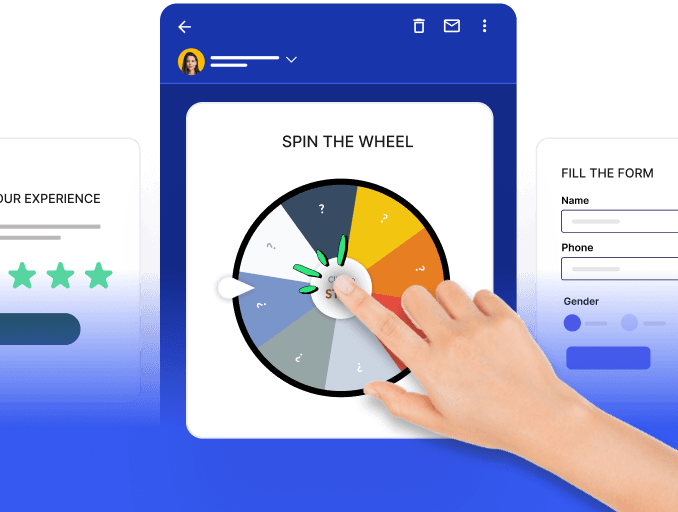We're all familiar with brands that are distinguished solely by their logos. Going a step further, some brands are even identifiable just by their choice of fonts, layout styles or colour schemes. This is the principle behind building brand kits- a strategic approach to crafting instantly recognizable brand identities. A well-designed brand kit ensures that every visual aspect, from your logo to your chosen colours reminds the audience of your brand.
This article will explore the essential aspects of a good brand kit, help you set up one for your own brand , and share some real-world brand kit examples. It will also provide you with some best practices to follow when creating a brand kit for your brand.
Table of contents
- What is a brand kit?
- Why should you use a brand kit?
- How to set up your brand kit?
- Key elements of a brand kit
- 5 examples to inspire your brand kit
- Final takeaway
What is a brand kit?
A brand kit, commonly known as a brand style guide or brand manual, is a curated collection of visual elements that define your brand identity. These elements include your logo, colour palette, typography, imagery and other design components that contribute to your brand’s visual character.
This brand kit is your guide to uniformity across all brand communications, ensuring that your messages are instantly recognizable. It's not just about choosing an aesthetically pleasing design- it is the first step to creating a visual language your audience immediately associates with your brand.
Why should you use a brand kit?
Using a brand kit will help your business transform how it communities with consumers on a day-to-day basis. Here are a few reasons why you should use a brand kit:
Consistent design across all communication: A brand kit guarantees uniform design elements in every interaction with your audience.
Time-Saving Template Design: By providing pre-defined design elements, a brand kit streamlines the template creation process, saving valuable time.
Enhanced Brand Recognition: Using a brand kit ensures that your brand is easily recognizable by fostering a distinct and memorable identity.
Easy-To-Follow Guidelines: A brand kit equips everyone involved with clear guidelines to follow, ensuring that all communications align with an established visual identity.
How to set up your brand kit?
Setting up your brand kit is a one time task that can help your brand’s recognition in the long run. Mailmodo is an email service provider that offers this feature and once you have created an account for yourself, you can follow this step-by-step process to create your own brand kit:
Access your brand kit
Go to the templates tab and select the bran kit section.
Review and customise
Your brand library will already be created using information from your website. Click on ‘Review and Publish; or select specific components for customization.
Brand logo configuration
Upload your brand logo for the header and footer sections. This logo will replace the placeholder logos when using premade headers or footers in email templates.
Typography selection
Choose a default email body font, and set font sizes for H1, H2, H3, H4 and P tags for both desktop and mobile.
Create your colour palette
Build a colour palette with your business’s most frequently used colours. These colours will be readily available every time you use the colour picker.
Button configuration
Configure different button styles to signify different actions. When a button is included in the template, it defaults back to the primary button style.
Social media integration
Add links to your social media handles. Social media elements in the template will automatically default to the selected platforms.
Footer personalization
Personalise the footer with your company;s contact information. When a footer is inserted in the template, default information will be replaced with your company’s details.
Key elements of a brand kit
Let’s explore some elements of a comprehensive brand kit. These elements will help you maintain a consistent brand aesthetic and voice.
Brand logo
The brand logo is the visual centrepiece of a brand kit, serving as the primary identifier.. Strategically designing and placing your logo on your website, products, and marketing communication is the first phase of helping your audience immediately identify your business.
Colour palette
A carefully curated colour palette defines the brand's visual identity which includes the primary and secondary colours of your brand.Consistently applying this colour palette across different communication platforms ensures a unified and memorable user experience.
Typography
Typography guidelines dictate the fonts and styles used in a brand's communication. Select fonts that articulate your brand's message consistently and align with your brand image. Cohesive fonts across your logo, website, and other communication channels can contribute to building a seamless visual identity.
Buttons
By defining button styles, sizes, and colours, you can optimise your buttons for both visual aesthetics and functionality. Consistent placement and design will enhance user experiences and contribute to a more recognizable and user-friendly brand interface.
Social links
Consistency in presentation of social media icons and their placement ensures a cohesive and recognizable presence across platforms, strengthening the brand's social identity.
Footer text
The footer text provides essential information and often includes copyright details or disclaimers. The consistent formatting, language, and legal information maintains professionalism and adherence to legal standards throughout the brand's communications.
5 examples to inspire your brand kit
Netflix
Netflix's brand kit is exemplified by its emphasis on the red 'N' symbol, its preferred method for brand identification. Their kit contains explicit instructions on acceptable brand colours, combinations, space requirements, and optimal contrast ratios for readability.
Their brand kit goes one step beyond the basics by highlighting various applications of brand imagery.
Google
Google's brand kit is clear and precise. They provide distinct instructions on how to use their logo and other visual assets. The kit also outlines the spatial requirements around the logo and instructions on using Google's official colours, product names, and icons.
Slack
Slack's brand kit has detailed guidelines on the usage of their logo, typeface, and colour palette. This sets the stage for cohesive brand representation. These guidelines also extend to the acceptable backgrounds for their logo and the secondary colours that fit their brand image.
Medium
Medium's brand kit is simple and helpful. It is a valuable resource with clear instructions on logo usage, typography, and colour palettes. It is an insightful reference for creating a brand kit that combines simplicity and effectiveness.
Spotify
Spotify's brand kit provides detailed instructions about how to use Spotify's brand elements in various specific scenarios. For example, it emphasises using Spotify's icon when space is limited, maintaining a recognizable brand identity in all potential situations.
Final takeaway
A well-crafted brand kit is crucial for leaving a lasting impression and connecting with your audience.
By creating your own brand kit, you can develop a roadmap to authenticity and consistency that helps you shape your business's identity. This will help you maintain consistency, make your communication creation faster and stand out from your competitors.







